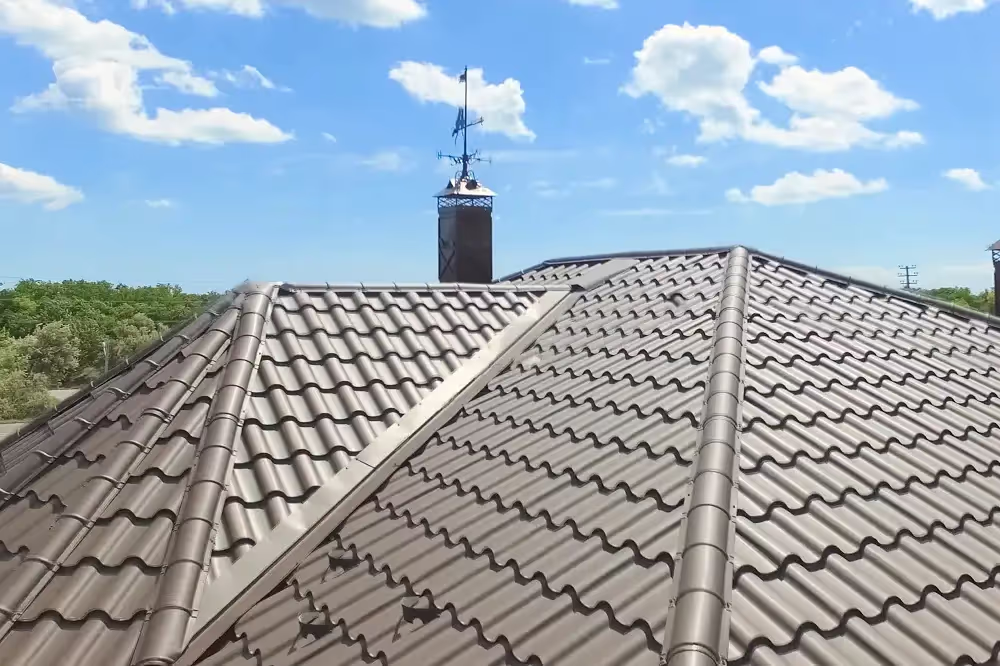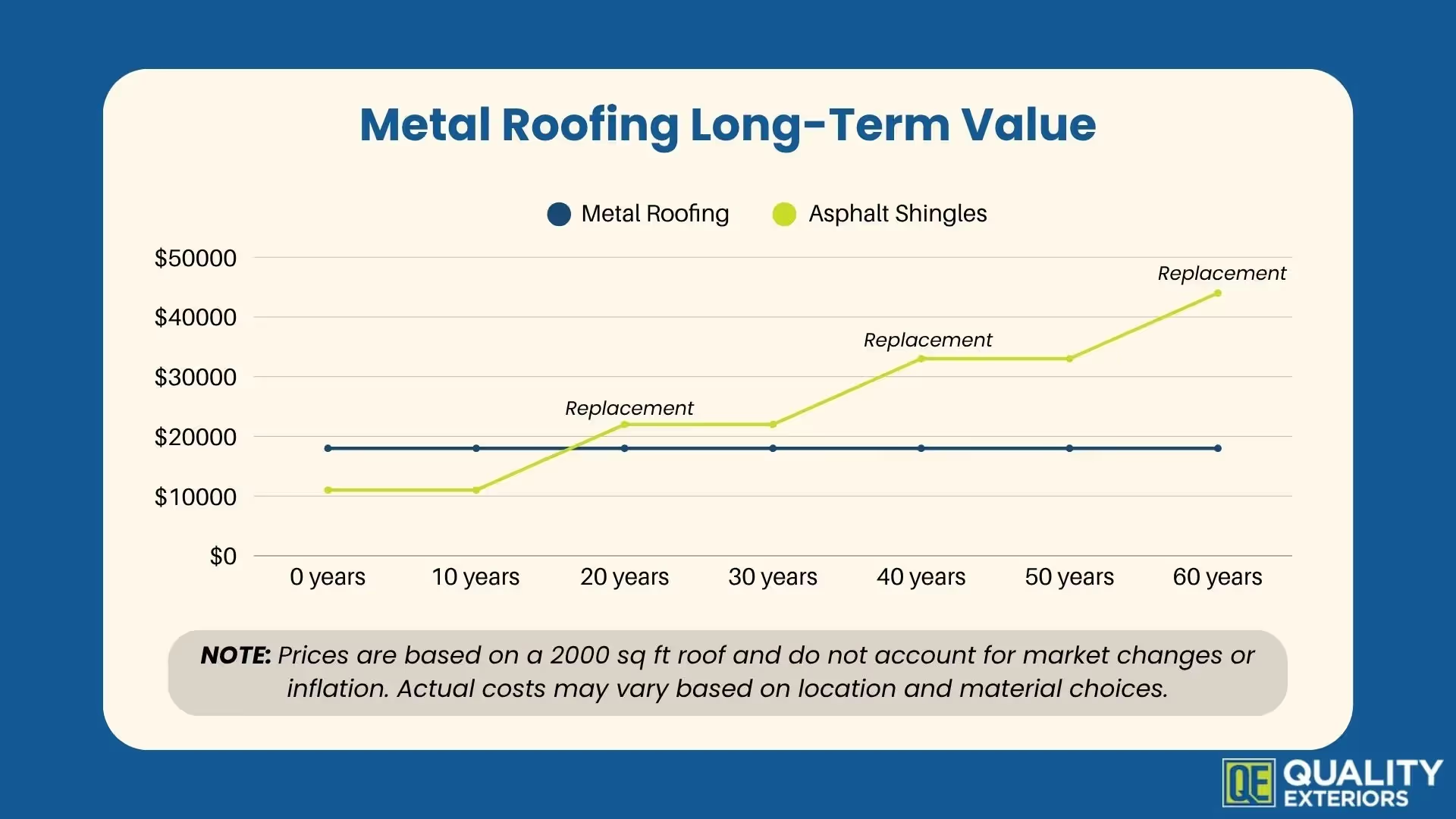Understanding Metal Roofing Materials
"Metal roofing" covers several materials, each offering different benefits, looks, and price points. Picking the right one for your home starts with knowing what each option brings to the table.
Steel Roofing
Steel roofing gives homeowners serious protection without breaking the budget. With a lifespan reaching 40 to 70 years, steel handles hail, heavy rain, and strong winds with ease. Galvanized coatings add extra rust resistance, making steel a dependable choice for anyone looking for a roof that stands up to Middle Tennessee’s tough weather.
Aluminum Roofing
Aluminum roofing is a natural fit for homes close to the coast. It stands up to salty air and moisture without rusting out. Being about one-third the weight of steel, it also makes installation easier and puts less pressure on your home’s frame. Aluminum does not need protective coatings to hold up, but it can dent more easily if heavy branches or hail come crashing down.
Copper Roofing
Copper roofing offers unmatched durability and aesthetic appeal. Over time, it develops a distinctive patina, which protects the material from further wear. While expensive, its longevity of over 70 years makes it a long-term investment, ideal for homeowners seeking a premium, low-maintenance option.
Zinc Roofing
Zinc roofing stands out for its ability to heal itself over time, with a natural patina that covers minor scratches and keeps the material looking good for decades. Its flexibility allows for creative, custom designs, while offering exceptional durability that often exceeds 80 years when installed properly. Zinc is also fully recyclable, making it a smart pick for homeowners who want low-maintenance living and care about sustainability.
Quick Overview of Metal Roofing Pros and Cons
Understanding the benefits and potential drawbacks of metal roofing is essential before making an investment. Before diving into details, here's a snapshot comparison of the primary benefits and limitations of metal roofing systems:
Now, let’s dive deeper into the advantages and disadvantages, so you can decide if a metal roof fits your home and your goals.
Why Metal Roofs Deliver Real Long-Term Value
The real-world benefits of metal roofing explain why more families are making the switch. For those focused on real, lasting value, the benefits often make the higher upfront price a smart move.
Exceptional Longevity and Durability
A well-built metal roof offers decades of protection, giving you real peace of mind. Most metal roofs last two to three times longer than asphalt, with top systems carrying warranties of 40 to 50 years. While many asphalt roofs need replacing after just 15–20 years, a properly installed metal roof can easily last 40–80 years, depending on the material you choose. That means one installation could be the only one you ever need.
Superior Weather Resistance
Metal roofs are built to stand up to tough weather. Quality metal roofing can handle winds up to 140 mph, making it a strong choice for homes in areas with hurricanes or tornadoes. These roofs also offer high impact resistance, meaning they can take on hail and heavy storms better than traditional shingles.
Energy Efficiency and Environmental Benefits

One of the standout features of metal roofs is their energy efficiency. By reflecting solar radiant heat, metal roofs help reduce the heat absorbed by your home, which in turn lowers cooling costs by 10–25%. Metal roofs’ energy-efficient properties can significantly reduce the workload of your air conditioning system, especially in warmer climates.
From an environmental perspective, metal roofing stands as one of the most sustainable building material choices available. Many metal roofing materials, such as galvanized steel, are made from recycled materials, and at the end of their lifecycle, they are 100% recyclable. This makes metal roofs a more eco-friendly option compared to traditional roofing materials, like asphalt shingles, which contribute heavily to landfill waste.
Simple Maintenance for Busy Homeowners
Metal roofing needs very little upkeep compared to other options. Besides occasional inspections and basic debris clearing, there is not much to worry about. Unlike asphalt shingles, metal surfaces do not attract moss or mildew, and they stand strong against UV rays without wearing out.
Aesthetic Appeal and Design Versatility
Today’s metal roofing is built to fit almost any style you want. You can find everything from sleek standing seam panels to classic metal shingles and bold corrugated looks. With dozens of colors and finishes available, it’s easy to match your roof to your home’s design — whether you want a modern edge or a more traditional look that fits right in.
#cta_here
Potential Disadvantages of Metal Roofs to Consider
Metal roofing comes with real advantages, but there are also a few challenges to keep in mind. Knowing the full picture helps you make a decision you can feel good about for years to come.
Noise Concerns
One of the most common worries about metal roofs is noise during heavy rain. Thankfully, modern installation methods cut sound levels down to what you would expect from traditional asphalt shingles. Solid sheathing, proper underlayment, and good insulation all work together to minimize noise so you can stay comfortable inside no matter the weather.
Denting and Damage Risks
While metal roofing stands up to most weather, large hailstones (over 1.5 inches) or falling tree limbs can sometimes cause dents, especially in softer materials like aluminum. If you live in a high-impact area, it is smart to choose thicker metal panels or impact-resistant products with a Class 4 rating for extra durability.
Rust and Corrosion Potential

If metal roofing is not properly finished, it can be vulnerable to rust over time. That is why top-quality systems include multiple layers of protection, like galvanization, primers, and specialized paint coatings with strong warranties against perforation. When you invest in a well-made system, corrosion becomes a non-issue for decades.
Installation Expertise Matters
Installing metal roofing the right way takes real experience and precision. Without proper technique, problems like leaks, thermal movement, and early system failure can happen. Working with a qualified contractor who specializes in metal roofing ensures you get the full value and lifespan you are paying for.
Higher Upfront Cost vs. Long-Term Value
It is true that metal roofing costs more upfront than asphalt shingles. Standard metal roofs usually run between $8 and $14 per square foot installed, with premium systems reaching $15 to $30 or more. That’s about two to three times the cost of a basic asphalt roof, and it can feel like a lot when you first see the numbers.

However, evaluating only the metal roof installation cost provides an incomplete picture. When analyzed across its entire lifespan, metal roofing often delivers superior value through:
- Maintenance savings: Minimal upkeep means you avoid the regular cleaning, treatment, and repairs that asphalt shingles require, saving you hundreds every year.
- Energy efficiency: Reflective metal roofing cuts cooling bills by 10 to 25 percent, especially helpful in warmer months.
- Return on investment: According to the Cost vs. Value 2024 Report, metal roofing projects deliver an average of 48.1% ROI, among the highest returns for exterior home improvements.
For homeowners planning to stay in their homes at least 7 to 10 years, the lifetime savings, durability, and added property value often outweigh the higher initial price. That’s why metal roofing continues to be a smart, cost-effective investment for families who plan ahead.
Is Metal Roofing Right for Your Home?
Choosing the right roofing material depends on a few key factors. Thinking through these points can help you decide if metal roofing is the best fit for your home and your plans:
- Climate considerations: Metal performs well in areas with extreme weather, including high winds, hailstorms, heavy rain, and tornado risks, providing strong protection against Middle Tennessee’s toughest conditions.
- Home architecture: Modern metal roofing complements virtually any style, with profiles that can boost your home's curb appeal while maintaining architectural integrity.
- Budget constraints: Those with limited immediate budgets might need to prioritize affordability over lifetime performance, despite metal's long-term financial benefits.
- Long-term plans: If you plan to stay in your home for many years, metal's low maintenance and 40-80 year lifespan deliver real financial benefits.
- Local regulations: Always check building codes and HOA rules to make sure metal roofing is allowed in your community.
Taking time to think through these points ensures you make a choice that protects your home today and brings lasting value for decades.









.avif)
